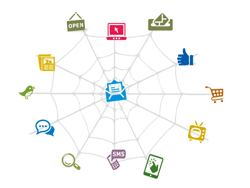Cross-channel marketing is a hot topic within the marketing industry today. Various buzzwords on the topic are being thrown around, including omni-channel, cross-platform, device map, deterministic connections, probabilistic connections and match rate—to name a few. Although cross-channel solutions are being discussed, the topic is overwhelming for most people. To cut through the noise, let’s review the basics.
 Running an efficient targeted marketing campaign requires three things:
Running an efficient targeted marketing campaign requires three things:
- Building a predictive model that gathers consumer data to infer consumer interests and intent to purchase
- Access to media inventory where marketers can engage consumers via targeted campaign messages
- Ability to measure the impact of a campaign by attributing consumer purchases to specific marketing engagements
Several years ago, consumer targeting occurred within isolated channels, specifically the desktop web browser. The majority of data used for modeling consumer interests came from desktop web browser histories, and the success of a marketing campaign was measured by the purchases consumers made on a particular website.
There was no need for cross-channel marketing back then because consumers were identified by a unique anonymous identifier associated with a specific browser—called a “browser cookie ID.” This browser-targeting approach was good enough to achieve marketing goals in a digital marketing world dominated by cookie-based retargeting.
However, today the average consumer is associated with multiple browser cookie IDs because consumers have more than one computer, use different browsers, etc.—and a new browser cookie ID is generated each time a consumer deletes their cookies. As a result, a single consumer gets treated as several unrelated consumers, each identified by different browser cookie IDs.
At that time there were not enough benefits to justify the additional costs and complexity of cross-browser solutions (not to mention cross-device or cross-channel solutions) and cross-browser targeting did not exist beyond few, mostly unsuccessful, attempts.
What changed? Why are marketers talking about cross-device and cross-channel marketing? The shift to cross-channel marketing was driven by a few emerging trends:
- Consumers now digest digital media through multiple devices
- More consumers research products online before making offline purchases
- We’ve expanded digital targeting strategies beyond single-browser retargeting—starting with cross-device retargeting and moving toward targeting based on sophisticated predictive models
Meanwhile, marketers collect consumer activity history from the devices we use on a daily basis and stitch them together, connecting consumer offline data to digital data. This helps marketers build a more complete picture of consumer activity and develop more accurate consumer predictive models to use for efficient targeting in digital and cross-channel marketing campaigns.
Deterministic vs. Probabilistic
What would it take to connect offline data with all the digital data associated with the devices consumers use? There are two methods:
- Deterministic approach Establishes connections between devices and browsers that belong to the same user based on user registration data—meaning when a user logs into their account from different devices or browsers, these devices or browsers can be connected. If the user’s offline identifiers, such as e-mail or phone number, are a part of their account information, these identifiers can also be used to connect user offline data to digital devices
- Probabilistic (statistical) approach Establishes connections between different devices, browsers and anonymized user offline identifiers by leveraging statistical models.
Statistical models are built based on samples of deterministic connections between devices, browsers or offline identifiers—called a truth set or training set. Truth sets are usually too small for standalone use in large-scale marketing campaigns, but large enough to be used for training statistical models. These models are applied to all devices, browsers and anonymized offline identifiers to infer a probabilistic connection among them
Probabilistic connections are less accurate than deterministic, so why bother with the probabilistic approach? There are two major reasons:
- Only big players, like Facebook and Google, have the capabilities to build deterministic solutions at scale
- Probabilistic accuracy is good enough to run targeted marketing campaigns but using the deterministic solution will only bring marginal improvement
What would it take to build an efficient, cross-channel probabilistic solution to support efficient targeted marketing campaigns? Although there is no simple solution, there is an approach that can nudge the industry in the right direction. This approach is based on the following framework:
- Access to a reliable truth set, which includes a sample of deterministic connections between devices, browsers and anonymized offline identifiers
- Robust statistical models based on the truth set that infers connections between devices, browsers and user offline identifiers
- Model transparency and access to key model parameters
- An active feedback loop based on the results of live marketing campaigns, allowing continuous model evaluation and improvement based on campaign performance
Access to Connection Probabilities: Rationalizing scale vs. accuracy tradeoff
One of the most important model parameters that should be made available to marketers is the “connection probabilities” that two devices, browsers or offline IDs belong to the same user. Used within the framework, this will allow marketers to effectively address scale vs. accuracy tradeoff pertaining to the probabilistic approach.
As long as the marketer knows and trusts these connection probabilities, they can use the information to price media inventories more efficiently. Connection probabilities should directly influence the output of such models—a set of consumer interests and intent scores, where each score is directly correlated with the probability that the consumer has an interest or intent at that particular time.
The model should treat connection probabilities as relative weights assigned to the data collected via devices or channels associated with the connections. The higher a connection probability, the more weight should be assigned to the audience data collected.
The marketer should also have an inventory pricing strategy where the price for media inventories is correlated with interest and intent probabilities: the higher the interest and intent probability, the higher the price the marketer is willing to pay for the inventory. Additionally, data associated with less accurate connections provides relatively lower contribution to the inventory price. Finally, marketers should regularly feed live campaign performance data back into the models to continuously improve them, which helps resolve the scale vs. accuracy tradeoff within marketing campaign goals by constantly optimizing a cross-device solution based on the live campaign performance feedback loop.
Implementing the framework outlined above will not instantly make cross-device or cross-channel marketing more efficient for those using a probabilistic matching approach. As devices and channels continue to evolve and more consumer data becomes available, it will remain a challenge for marketers to track and connect everything. However, if the industry collectively begins to flesh out a better cross-device and cross-channel data framework, we will move a few steps closer to a more permanent solution.

Dimitri Vaynblat is chief technology and data officer at RadiumOne.
Related articles:
4 Must Do’s to Effective Cross-Channel Marketing
3 Tools for Cross-Channel Attribution
Knock Down Silos to Map the Customer Journey


 Network
Network

